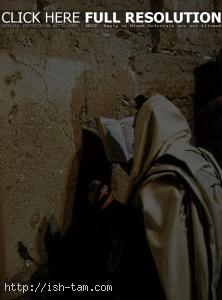
Tefillah is extremely potent spiritual tool, however like every tool it needs proper tuning and usage skills – that’s what we’ll try to cover in this posting.
There is a tremendous amount of literature dealing with the topics of prayer and meditation, however there is a lot of ambiguity in the meaning people give to those terms.
Here is the Wiki definitions:
“Prayer is a form of religious practice that seeks to activate a volitional connection to some greater power in the universe through deliberate practice”
“Meditation is a holistic discipline by which the practitioner attempts to get beyond the reflexive, “thinking” mind into a deeper state of relaxation or awareness”
Those definitions might be culturally accurate but they give little insight into the principles of how Tefillah and Meditation work.
The working definitions that help us would be:
“Prayer is an active act of changing the reality through changing yourself”
This definition is the resolution of the Paradox of the Prayer.
The paradox is frequently presented as this argument:
“If G-d knows what’s good for me, he will give it to me anyway as loving Father would – why would I need to pray? On the other hand, if something is not good for me, he won’t give it to me anyway even if I ask for it, so why pray?”
This simplistic approach doesn’t take into account that our life is a reflection of who we are on all levels of our soul and our body; our experience is a mirror of our entire self, which is the sum of all levels of our consciousness.
Since Hashem reflects to us exactly who we are, the way to change our reality is to change ourselves. The Change takes energy – the deeper is the level of the change, the more energy it takes.
Tefillah, prayer, is the primary tool for any change, spiritual and physical.
In order to use Tefillah, we need to focus and channel energy along the pathway of our desire, desire to change ourselves.
So our desires define the channels along which the energy of the Tefillah is directed and flow, the more refined and holy are the desires, the deeper and more elevated will be the change.
Ideally, during Tefillah our Higher Self, our soul takes over and gives us the direction to pray.
This is the meaning of short verse from Tehillim (51:17) we say before the Amidah prayer:
“Hashem, open my lips that my mouth may declare your praise”.
Our Lower Self (body/nefesh) supplies the energy for the Tefillah, our Higher Self gives us the desire/direction, and the process works in the unison towards the same goal of elevating the world, changing all of “me” and all of reality.
In a wider sense we can view “me” as the handle to the reality. Since everything is connected, our self is an integral part of the entire creation and the entry point into all levels of existence.
This is another perspective why changing the “self” is the only way to change the reality:
We can’t open a door by banging our head against the wall (unfortunately that’s how most people are trying to change the reality), we have to find the door (realize there is a proper way of changing the reality – Tefillah), grasp/turn the handle (learn to use Tefillah dynamics), open the door and come through.
The energy for Tefillah sometimes might come from above as well – particularly on Moadim and Hagim – Jewish holidays, so we can use the tremendous wave of holiness descending on those days to power up our Tefillah. Every special time (Moed) has it’s own energy flavor and helps to rectify/change the respective area of our soul (Pesach supplies energy of freedom, Shavuot is great for “upgrading” to higher level of consciousness, Succot allows us to achieve the state of joy, etc. )
Speaking about receiving energy from above, brings us to the second part of the whole –
Meditation and the role it plays. Without getting into the definitions and semantics of what word “meditation” means to different people, we’ll say that meditation is conducive to entering into the state of internal balance, the state of being connected to the subconscious part of mind, state of being nullified and open to receive from above.
If Tefillah can be very forceful, pushing and channeling energy with one’s will,
This state of meditation is completely opposite – it doesn’t allow any tension or forcefulness, it’s completely let go, opened and relaxed, like a flower under the sun, all one’s body, mind and soul tuned in to receive.
It is said in Gemora that Chassidim Rishonim (Early Saints) would spend three hours each prayer service:
An hour for Pre-Tefillah meditation, an hour for the Tefillah itself, and an hour for after-Tefillah meditation. If we view meditation as the “recharge” operation and Tefillah as the energy-spending act, it is very probable that Chassidim Rishonim would accumulate energy before the Tefillah and restore it afterwards.
Hence Tefillah and Meditation have been two inseparable practices in Jewish tradition from the ancient times; those two are as breathing in and breathing out, being two sides of the same coin. Tefillah is working according to the male principle (in Kabbalistic definition), actively changing reality, Meditation according to female, passively receiving energy (to beused for the active stage). When one’s Tefillah/Meditaton is structured according to this male/female dynamic, the result is harmonious spiritual growth.
One of the reasons for the tremendous power of Tehillim (Psalms), is that they seamlessly combine both modes. They draw the energy from the spiritual realm and this energy is channeled towards the target of reading the Tehillim (being another person or situation).
Most people however have emphasis over one or another mode, frequently not even realizing the second mode even exists. So the neglected mode is happening subconsciously somewhere on the background, which greatly slows down one’s spiritual growth.
One has to be aware of this male/female dynamic to feel when is the right time for which stage. The high-energy stage is asking for the male Tefillah mode and energy-depleted or mellower state is conducive to the female Meditation mode.




